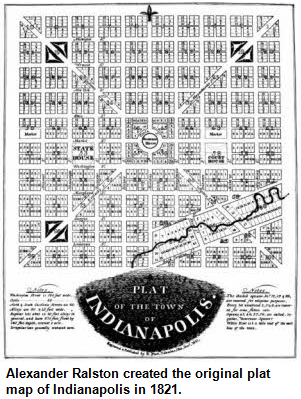Jan 18, 2020
(January 4, 2020) With our first show of the new year, Hoosier History Live looks both backward and forward.
That's because our focus is not only on how the city of Indianapolis celebrated its 100th birthday in 1920, but also on how the Hoosier capital plans to salute its bicentennial jubilee, which kicks off in June. We also explore what happened in 1971, when Indy threw a year-long sesquicentennial (or 150th) birthday celebration.

In June 1920, an "Indianapolis Centennial Pageant" at the Coliseum on the Indiana State Fairgrounds consisted of seven "episodes," or acts, with titles such as "Coming of the Pioneers" and "Selecting a Site," according to booklets and other memorabilia distributed then.
Reenactors portrayed such historic characters as early settlers John McCormick and George Pogue; Indiana's first governor, Jonathan Jennings; surveyor Alexander Ralston, who planned the city, and Dr. Isaac Coe, one of the first physicians to arrive in the new state capital.
The grand finale of a six-day birthday party for the city's centennial in 1920 was held at the White River. Thousands of residents lined the river banks for a band concert and enjoyed a parade of illuminated riverboats, followed by fireworks, according to the Encyclopedia of Indianapolis.
In 1971, the city's 150th birthday involved a year-long celebration that included a multimedia extravaganza at the Murat Shrine Temple (now the Murat Theatre at Old National Centre). The Indianapolis Motor Speedway hosted a special antique car parade and race.
A note on the disparity of dates: The city's centennial was celebrated in 1920 after civic leaders decided to identify 1820 as the birth of the city because of a meeting held that year to specify the location of the new state capital. In 1971, however, the founding was defined as 1821, the year when the Indiana General Assembly approved the site and Ralston laid out the city.
 Hoosier History Live has
explored aspects of Indy's deepest history on previous programs.
These have included a show in
June 2019 about the earliest settlers. The guests were
a descendant of McCormick (who built a cabin and tavern in what is
now White River State
Park) and Jordan Ryan of
the Indiana
Historical Society, which has launched
an Indianapolis
Bicentennial Project. In 2013 we
explored the life of Ralston (1771-1827), a
native of Scotland who helped plan Washington D.C. before coming to
the Indiana wilderness and designing the city.
Hoosier History Live has
explored aspects of Indy's deepest history on previous programs.
These have included a show in
June 2019 about the earliest settlers. The guests were
a descendant of McCormick (who built a cabin and tavern in what is
now White River State
Park) and Jordan Ryan of
the Indiana
Historical Society, which has launched
an Indianapolis
Bicentennial Project. In 2013 we
explored the life of Ralston (1771-1827), a
native of Scotland who helped plan Washington D.C. before coming to
the Indiana wilderness and designing the city.
Our guest on this new show, Jeff Bennett, has a history degree from Indiana University and has been deputy mayor since 2016. His career includes serving as Warren Township's trustee and working at Indiana Landmarks, the historic preservation organization.
The Bicentennial that kicks off in June 2020 is being described as the celebration of an "era" because it will extend through May 2021 as a salute to historic events in both 1820 and 1821. The Bicentennial Commission already has endorsed several projects, including some being organized by Visit Indy and Indy Hub.
Jeff Bennett describes those projects during our show as well as a Bicentennial mural series sponsored by the Arts Council of Indianapolis.
Last year, city leaders also invited submissions from artists for a Bicentennial logo. The winning logo will be unveiled later in January.
Community groups, including neighborhood organizations, have been urged to submit proposals that may be endorsed as Bicentennial projects. According to Jeff, the roll-out eventually will involve an announcement every month about endorsed community projects along with partnerships involving various sports, arts, civic and cultural organizations.